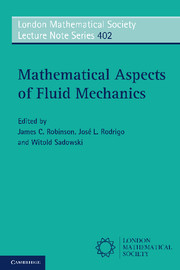Book contents
- Frontmatter
- Contents
- Preface
- List of Contributors
- 1 Towards fluid equations by approximate deconvolution models
- 2 On flows of fluids described by an implicit constitutive equation characterized by a maximal monotone graph
- 3 A continuous model for turbulent energy cascade
- 4 Remarks on complex fluid models
- 5 A naive parametrization for the vortex-sheet problem
- 6 Sharp and almost-sharp fronts for the SQG equation
- 7 Feedback stabilization for the Navier–Stokes equations: theory and calculations
- 8 Interacting vortex pairs in inviscid and viscous planar flows
- 9 Stretching and folding diagnostics in solutions three-dimensional Euler and Navier–Stokes equations
- 10 Exploring symmetry plane conditions in numerical Euler solutions
- 11 On the decay of solutions of the Navier–Stokes system with potential forces
- 12 Leray–Hopf solutions to Navier–Stokes equations with weakly converging initial data
- References
7 - Feedback stabilization for the Navier–Stokes equations: theory and calculations
Published online by Cambridge University Press: 05 November 2012
- Frontmatter
- Contents
- Preface
- List of Contributors
- 1 Towards fluid equations by approximate deconvolution models
- 2 On flows of fluids described by an implicit constitutive equation characterized by a maximal monotone graph
- 3 A continuous model for turbulent energy cascade
- 4 Remarks on complex fluid models
- 5 A naive parametrization for the vortex-sheet problem
- 6 Sharp and almost-sharp fronts for the SQG equation
- 7 Feedback stabilization for the Navier–Stokes equations: theory and calculations
- 8 Interacting vortex pairs in inviscid and viscous planar flows
- 9 Stretching and folding diagnostics in solutions three-dimensional Euler and Navier–Stokes equations
- 10 Exploring symmetry plane conditions in numerical Euler solutions
- 11 On the decay of solutions of the Navier–Stokes system with potential forces
- 12 Leray–Hopf solutions to Navier–Stokes equations with weakly converging initial data
- References
Summary
Abstract This paper considers the feedback stabilization problem for the Navier-Stokes equations defined in a bounded domain. Control via a forcing term (both distributed and impulsive) supported in a subdomain, via the initial condition, and via boundary conditions are studied, and relationships between these different kinds of control are presented. The precise meaning of ‘feedback control’ is discussed, and a feedback map providing control via the state variable is constructed for initial and distributed control (in the latter case for the linear Oseen equations only). Numerical algorithms for the calculation of stable invariant manifolds and projection operators on these sets are discussed. Finally the results of a numerical stabilization of a particular fluid flow are presented.
Introduction
The aim of this paper is to give a relatively short presentation of mathematical and numerical results concerning stabilization of the Navier-Stokes equations by feedback control. A description of the mathematical stabilization construction will be accompanied by a discussion of how mathematical notions of stabilization theory can be adapted to calculations.
Control theory for partial differential equations has been developed very intensively over the last few decades, and is now a very wide and farreaching field, even if one excludes extremal theory for partial differential equations. For some idea of this field more broadly, see the recent books by Coron (2007) and Tucsnak & Weiss (2009), as well as the earlier survey in Fursikov & Imanuilov (1999), together with the references in these publications.
The stabilization problem for the 2D Navier-Stokes system by a feedback distributed control supported in the whole fluid domain was studied by Barbu & Sritharan (1998).
Information
- Type
- Chapter
- Information
- Mathematical Aspects of Fluid Mechanics , pp. 130 - 172Publisher: Cambridge University PressPrint publication year: 2012
References
Accessibility standard: Unknown
Why this information is here
This section outlines the accessibility features of this content - including support for screen readers, full keyboard navigation and high-contrast display options. This may not be relevant for you.Accessibility Information
- 14
- Cited by
